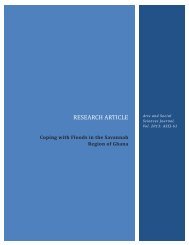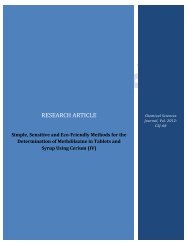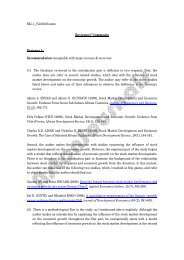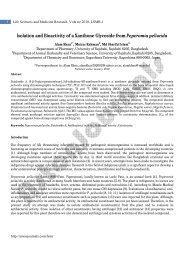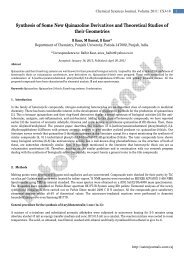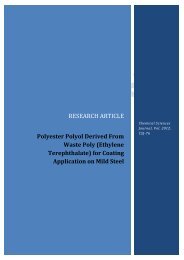An Efficient Synthesis of Biologically Active ... - AstonJournals
An Efficient Synthesis of Biologically Active ... - AstonJournals
An Efficient Synthesis of Biologically Active ... - AstonJournals
You also want an ePaper? Increase the reach of your titles
YUMPU automatically turns print PDFs into web optimized ePapers that Google loves.
8 Research Article4. Biological ActivityBacterial infection causes high rate <strong>of</strong> mortality in human population and aquaculture organisms [23]. For example,B. cereus is responsible for causing foodborne diseases [24]. S. aureus causes diseases such as mastitis, abortion andupper respiratory complications, while Salmonella sp. causes diarrhea and typhoid fever [25]. The revolutionizedtherapy <strong>of</strong> infectious diseases by the use <strong>of</strong> antimicrobial drugs has certain limitations because <strong>of</strong> changing patterns<strong>of</strong> resistance in pathogens and side effects they produced. These limitations demand for improved pharmacokineticproperties, which necessitate continued research for new antimicrobial compounds for the development <strong>of</strong> drugs[26]. So accordingly, pharmaceutical industries are giving importance to the compounds derived from quinazolinedionesources.4.1. Bacterial source and culture conditionsThe bacteria used in this study were S. aureus, S. typhi and B. cereus (obtained from the Pathology Department, Faculty<strong>of</strong> Veterinary Medicine, South Valley University). These bacterial strains were maintained on suitable medium at 48Cand subcultured on Mueller Hinton Broth at 378C for 18 h before testing.4.2. <strong>An</strong>tibacterial assaysMost <strong>of</strong> the tested compounds exhibited antibacterial activity against all the tested bacterial species. The gramnegativeS. typhi was the most sensitive to most <strong>of</strong> the compounds tested (2a–d and 3f). The higher antibacterialactivity (indicated as zone <strong>of</strong> inhibition) was recorded for compound 3f followed by 2d and 2f (11, 10 and 10 mm),respectively (Figure 1). Hence, the susceptibility <strong>of</strong> the gram-positive B. cereus to compounds 2d, 2f, 3a, 3e–g wasmore pronounced when compared to the other tested compounds. The most observed antibacterial activity wasrecorded for compound 2d for both gram-positive and negative bacteria; this may be due to the four chlorine atoms[27] and pyrimidine ring [28–30]. On the other hand, S. aureus and B. cereus were resistant to compounds 2a–c, whilethey were sensitive to the other compounds. It is worthy to mention that the clear zone caused by compounds2a, b and d with S. typhi was nearly closely to the inhibition zone caused by tetracycline disk; the sensitivity <strong>of</strong>these bacteria toward our compounds may be due to the presence <strong>of</strong> four chlorine atoms [27] and pyrimidine ring[28–30] (Figure 1). The efficiency <strong>of</strong> compounds 2a–d, and 3f as antibacterial products recorded the highest inhibitionwith the gram-negative bacteria; while 2d, 2f, 3a, 3e–g were more efficient for gram-positive bacteria. Thus,Figure 1: <strong>An</strong>tibacterial activities <strong>of</strong> quinazoline dione compounds against some gram-positive and negative bacteria.http://astonjournals.com/csj


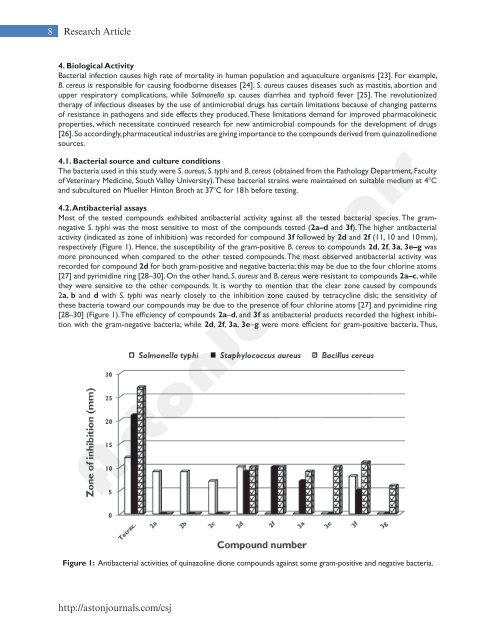
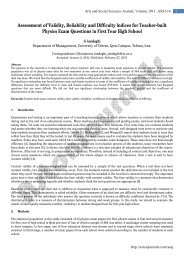
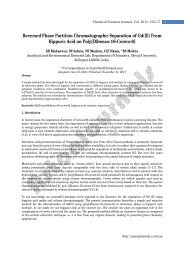
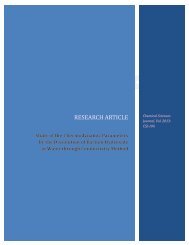
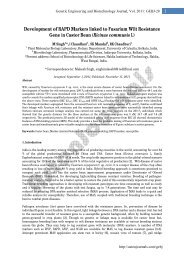

![[1,4]-benzodiazepine-2-one Derivatives as Potent - AstonJournals](https://img.yumpu.com/49117784/1/184x260/14-benzodiazepine-2-one-derivatives-as-potent-astonjournals.jpg?quality=85)
